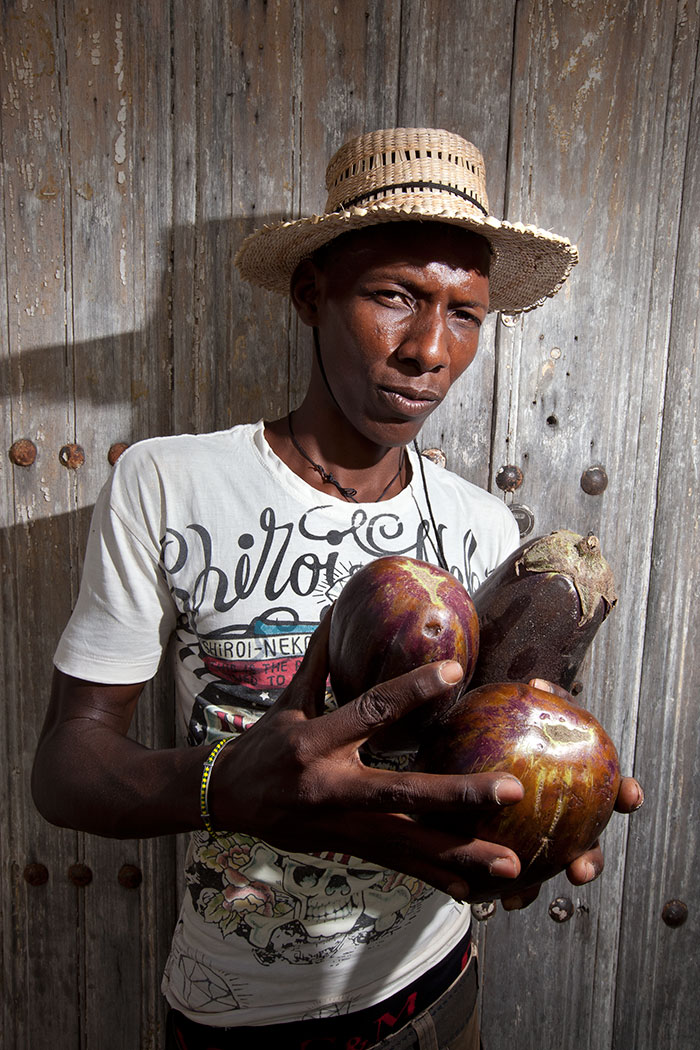
More than a million Canadians will travel to Cuba this year. The only places beyond our borders that attract more of us are the United States and Mexico. There is no other tourist destination on earth where Canadians are so dominant, and possibly none where the tourist economy is more vital to the nation’s immediate economic health. With little in the way of formal policy and with no real intent on the part of the beach-bound hordes, we’ve established a relationship with Cuba that is unique in both our histories. We’ve colonized Cuba on vacation by accident.
This is a story about what happens when the unarticulated, half-hidden nature of that colonial relationship is suddenly exposed. It’s an economics lesson in the form of a parable, a traveller’s tale about the strange connection between master and servant in this de facto tourist colony.
So let’s begin, in fairy-tale fashion, in a tower atop a castle: the rooftop terrace of Hotel Casa Granda in Santiago de Cuba, the country’s second-largest city. The Casa Granda is an old colonial half ruin overlooking a wide square and an elegant cathedral. It’s an atmospheric, Graham Greene kind of place, five storeys tall and colonnaded and shedding white paint. I found myself there at sunset one January evening, sipping a mojito and pondering the real value of ten convertible Cuban pesos.
Because Cuba is among the few nations on earth with two official currencies, a never-never-land economy caught in its own distended bubble halfway between the collapsed Soviet bloc and the contemporary global capitalist order, visitors can find themselves wondering more than usual about exchange rates. There is the regular, nonconvertible peso, officially the Cuban peso or CUP, used to buy staple goods at state-run shops. And there is the convertible peso, the CUC—the hard currency, which is used for luxury goods and provides the default banknotes for the tourist economy. In government accounting, CUCs and CUPs are valued one to one, but informally the CUC is worth about the same as the Canadian dollar, while the CUP has a street value of a nickel at most. CUPs are worthless outside Cuba, except as souvenirs.
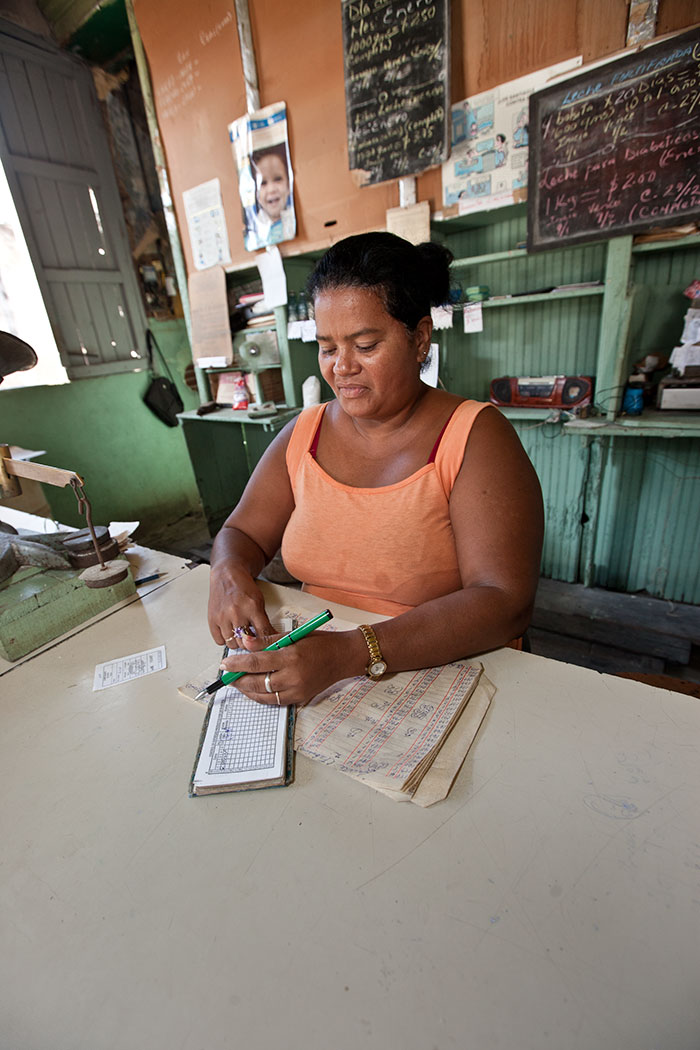
Earlier in the day, I’d had ten CUCs snatched from my hand, and I was up on the roof of the Casa Granda trying to figure out what exactly had happened and how I really felt about it. It’s rare, once you’re well into the mortgage-and-kids phase of adulthood, to encounter a whole new category of emotion, but I was pretty sure I’d done just that out there on a dusty Santiago back street, and now I was probing the feeling to discern its dimensions.
What happened, in brief, is that my wife and I had hired a young man named Antonio to give us a tour.* We’d spent the morning chugging around in an ancient Moskvich sedan, with another young man driving as Antonio pointed out the sights and delivered a running commentary about what he called “the reality of Cuba.” We’d visited an Afro-Cuban cultural museum, toured the old Spanish fort, bought contraband rum. We’d gone back to Antonio’s tiny concrete box of a home, met his wife and mother, sipped beers, talked some politics, and taken pictures. In the late afternoon, he and another friend had led us to a lovely little restaurant at the base of Santiago’s landmark Padre Pico steps. We’d eaten grilled lobster, drunk more beers, and traded jokes and vows of eternal friendship.
* To protect individuals’ identities, some names have been changed.
At the end of the meal, I’d given the waiter CUC $80 and received CUC $10 in change, and as I stood there with the ten-peso note in my hand Antonio grabbed and pocketed it. I shot him a confused look, and he responded with a half shrug that seemed calibrated somewhere between What’s it matter? and You know the score. I hadn’t intended to give him the money, but he decided he deserved it. Hours later, on the rooftop patio of the Casa Granda, drinking a mojito that cost nearly half the amount I was obsessing about, I wondered what that shrug really meant.
This had all occurred in that informal, sketchily delineated commercial zone that springs up in pretty much any robust tourist economy, a grey market that is particularly broad and heavily trafficked in countries where visitors and locals are separated by wide gulfs of wealth, power, or political freedom. In Cuba, Antonio and I stood on opposite sides of a divide created by a substantial admixture of all three.
We were under no illusions, my wife and I. We understood that Antonio was, in local parlance, a jinetero—a tout or fixer, though in Cuba the word often suggests a darker meaning: hustler or scam artist. We’d participated in a drawn-out haggling courtship with him across a couple of days, a dance familiar to us from other trips to countries with bustling grey markets. There had been repeated encounters on a busy street in front of a tiny, decrepit photo studio that may or may not have been his usual place of work. He’d presented us with a gift of a photo and some cheap cigars, and we’d discussed the possibility of a city tour as if it were a friendly outing and not a paid transaction. We’d checked with the tour desk of the Meliá hotel, the only full-service resort in town, and knew that an organized tour in an air-conditioned bus would run us more than $100. We preferred the idea of giving our hard-currency CUCs and maybe a gift or two to an enterprising jinetero instead of to a government-controlled joint venture.
It was the right choice, and we had no regrets. It had been a fun day, revelatory in ways an official tour never could have been, and we’d been generous with Antonio and his family, paying out his fee in bits and pieces, in overpayments and unasked-for change. I’d overpaid for drinks at the Afro-Cuban cultural centre, handed him too much money by a factor of at least five to pick up a six-pack of beer to share back at his house. We’d stopped back at our hotel at the end of the tour and filled a bag for him and his family with markers, notebooks, two toothbrushes, some new towels, and a used pair of Adidas shorts. We’d paid him and the driver CUC $20 each for their work as guides—the equivalent of a month’s wages in a typical government job—and had bought him and his other friend lobster dinners (another month’s wages, although the place never would’ve served Cuban diners on their own, even if they’d had the CUCs).
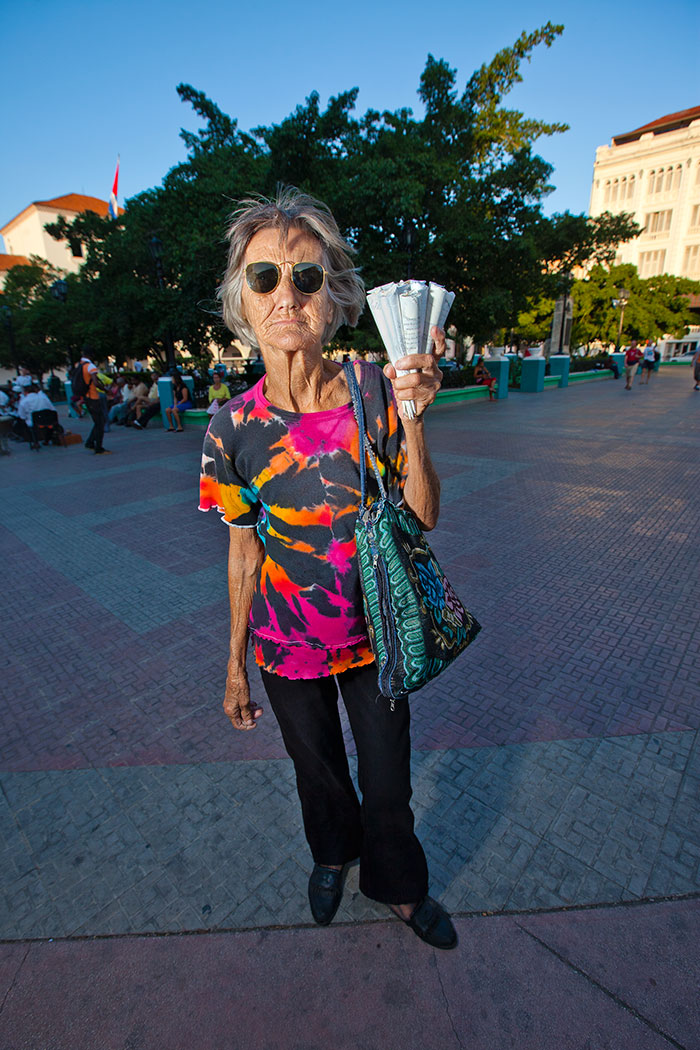
So, yes: we all knew roughly what the score was. But to Antonio’s mind, I’d come up with a figure at least CUC $10 too low, and he’d taken it upon himself to round it up. At first, standing in the street outside the restaurant as he and his friend departed in a flurry of hugs and warm handshakes, I’d felt something verging on a sense of violation. Had I been robbed? Had I been—that most dreaded of veteran traveller fears—played somehow? Was I a sucker?
With the clarity of a second mojito and the brilliant sunset over Santiago Bay, I knew that wasn’t it. This wasn’t a robbery or a con. This is why it felt so weird: it wasn’t about what had happened to me; it was about who I was in Cuba. This had been a refusal to hew to the script of colonial power. It was a servant’s insubordination before his colonial master. It was, I came to think, a profoundly Cuban way to read the situation.
Of course I could spare the ten pesos, and Antonio had earned it and then some. I’d seen just enough to imagine how hard it would be for him to get his hands on another CUC $10 note, and he understood all too well how effortless it was for me to obtain a big stack of them. He wasn’t fully invested in the tourist economy’s cold logic of wealth and status, and he certainly didn’t feel he owed me any deference. He’d simply taken what was rightfully his, an inverted colonial tax on the day’s transaction. Quite literally, it was what the market would bear on that particular day in Santiago.
By the time I’d reached the mashed lime and mint leaves at the bottom of my second mojito, I saw the whole thing much more clearly: me and Antonio, Cuba and Canada, the whole trip. The real exchange rate on ten convertible pesos preoccupied me for the rest of our visit and cast new light on the month’s preparation leading up to it. Ten pesos was a bargain, really, for all that had been revealed.
Afew days before we departed for Cuba, we stopped by the Wal-mart in Antigonish, Nova Scotia, where we were visiting my parents for Christmas. We had pictures to get printed and some final purchases to make in preparation for the trip: sunscreen, medication, a high-capacity memory stick. One of the unspoken assumptions in Canada’s colonial relationship with Cuba is that tourists import stockpiles of consumer goods to hand out to locals. In Cuba, unlike the rest of the beach holiday Caribbean, it’s not just that people can’t afford as much as we can, but that much of what we take for granted is completely unavailable in Cuba’s truncated marketplace. I’d been reading on the Internet about what people suggested to bring: dental floss, shampoo, good towels, baseballs, vitamins and medicines, toothbrushes and school supplies, hardware and reading glasses.
We wandered Wal-mart’s over-lit aisles, past overflowing shelves, filling a cart with pens and notepads and econo-sized bottles of acetaminophen. We had our five-year-old daughter in reluctant tow, and she settled into a shelf piled with towels as if it were a bunk bed while we had an absurd debate about which of them to buy. The towel aisle had at least four distinct gradations of price and quality. I’d written “high-quality towels” on my list and put a big asterisk next to it, but I couldn’t remember whether I was reminding myself that towels were so useful we should buy as many as possible or that Cubans needed particularly high-quality towels. In the end, we bought two bath towels ($5 each), four washcloths ($2 each), and two hand towels ($4 each). By the time we reached the checkout, I could no longer remember whether they were higher in the quantity or the quality range. The total bill was $186.82, the equivalent of nine months’ average wages in Cuba. We paid with the swipe of a card and a tired shrug.
This, of course, is the way of the Canadian economy nowadays. We’re delirious with choice, so completely buried in our own abundance that it inspires reality TV series. Many of us rarely bother with cash; some digital chirrup races at the speed of light from Walmart’s till to a server farm representing the bank’s vault, and by the time we hit the automatic exit we can’t remember whether we paid $176 or $186 for the dead weight filling our cart. You could lose CUC $10 just by forgetting to put back that pack of fancy pencil crayons your kid tossed in while you were distracted.
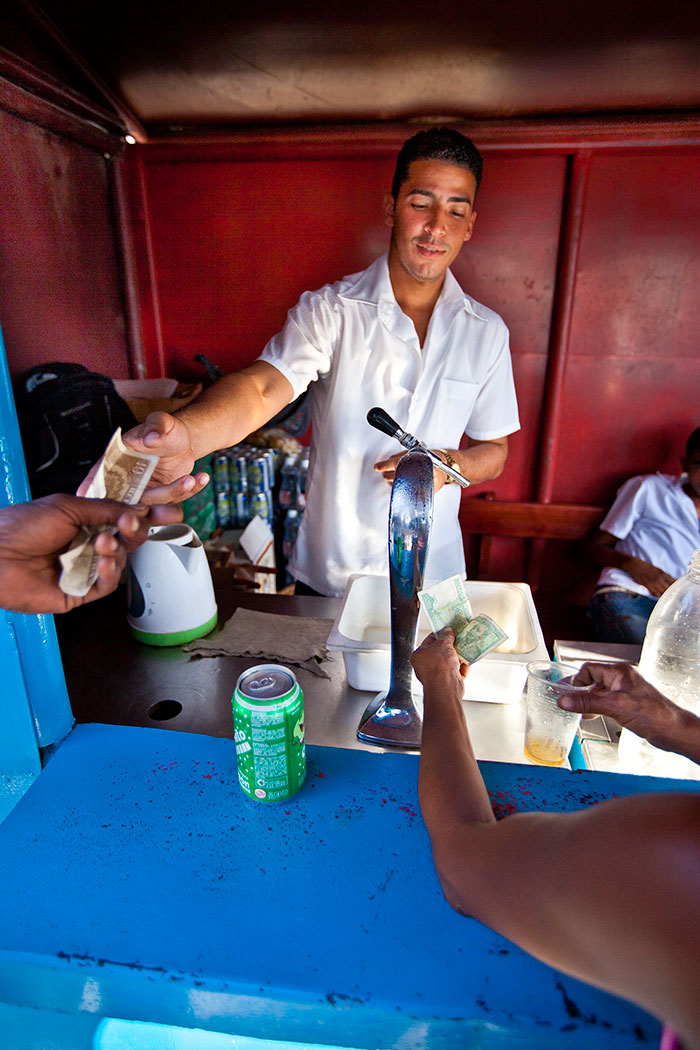
For all the arbitrary afterthoughts that govern its periphery, Canada’s relationship with Cuba, economic and otherwise, is a significant one. Canada and Mexico were the only Western nations that didn’t cease diplomatic relations with Cuba during the tense missile crisis years of the early ’60s, and Fidel Castro was close enough to Pierre Trudeau that he served as an honorary pallbearer at the former prime minister’s funeral in Montreal. In the annals of Canadian diplomacy, there is no other international relationship in which Canada has stood as far apart from the US.
As a reward for our enduring friendship, Canada is probably the second most important economic ally Cuba has after Venezuela, which supplies more than 60 percent of the island’s oil. (China exports more stuff to Cuba, but the Chinese don’t show up daily by the multiple charter-flight-loads to hand out gifts and pour hundreds of millions of dollars into the Cuban economy.) Cuba is our largest trading partner in the whole of Central America and the Caribbean. We export a range of commodities to Cuba—sulphur, wheat, copper wire—and we are the second-largest buyer of Cuban exports, particularly sugar, nickel, fish, citrus fruits, and tobacco. That’s over $1 billion in total trade. The Canadian mining company Sherritt International has a huge presence in Cuba, digging up nickel; and Toronto-based Pizza Nova, the only foreign pizza joint in the country, has operated six outlets scattered across the island. Back home, meanwhile, souvenir shops in many Canadian cities feature humidors well stocked with Cuban tobacco products for sale to American tourists. The Cuban cigar has become, in a sense, as Canadian as maple syrup.
The economic view from the other end of this relationship is nowhere near as rosy. Since the collapse of the Soviet Union in the late ’80s, Cuba has struggled through a punishing “Special Period” during which its economy has existed in its own isolated socialist limbo: tethered to a failed Communist order, still barred from regular trade with the world’s largest economy just 145 kilometres across the sea, desperate for imports and the hard currency to pay for them. As Soviet goods vanished from Cuban pantries in the first years of the Special Period, the average Cuban’s calorie intake plummeted by 30 percent, and the local diet has never fully recovered. Cuba remains reliant on imported goods (increasingly, under a special exemption, from the US) for somewhere between 60 and 80 percent of its food. Cubans also switched almost overnight to organic and in some cases pre-industrial forms of local food production; the island has experienced a boom in the production of yokes and plows for use with oxen, for example, among many other austerity measures adopted to weather the Special Period’s rough, uncertain seas.
Austerity’s limits, though, are now lapping perilously high against the makeshift vessel’s sides. Since June 2009, Cuba has operated under emergency energy quotas in a program known as “Save or Die,” while the government has been laying off workers, encouraging small business development, and sending so many doctors abroad (as trade in kind for vital commodities such as oil) that there are now nearly twice as many Cubans caring for the sick overseas as there are working on the island. The government has begun to discuss phasing out subsidies for many staple goods, suggesting that the days are numbered for the ration stores that provide Cubans with much of their daily bread (and rice and beans and milk).
One recent study described Cuba’s current approach as “survival economics.” The Havana-based dissident blogger Yoani Sanchez, writing for the Huffington Post last August, summed up Cuba’s conundrum more eloquently: “We are in transition, something seems to be on the verge of being irreparably broken on this island, but we don’t realize it, sunk in the day-to-day and its problems… we are leaving behind something that seemed to us, at times, eternal.”
In the face of this deepening uncertainty, there remains one bright and intensifying light on Cuba’s troubled horizon, one safe port amid the Special Period storm: tourism. In 1990, at the dawn of this strange age, Cuba attracted 340,000 tourists; in 2011, it welcomed some 2.5 million. Since the announcement of the Save or Die program, Raúl Castro’s government has introduced ninety-nine-year leases for foreign investors, to encourage resort and golf course development; and it has loosened the restrictions on family-run, home-based restaurants (paladares) and guest houses (casas particulares), to provide more self-employment opportunities in the tourist sector. Meanwhile, one in four of the island’s 80,000 government tourist workers has a post-secondary degree. “Right now,” writes Sanchez, “the main incentive for those who work in snack bars, restaurants and hotels lies in the possibility of a visiting foreigner leaving them some material gratification.” More than a million of those foreigners, 44 percent of the total, are Canadians. The next-largest share, approximately 175,000, belongs to the British. Tipping, once regarded as counter-revolutionary and beneath the dignity of Cuban patriots, has become their most direct and vital connection to economic stability.
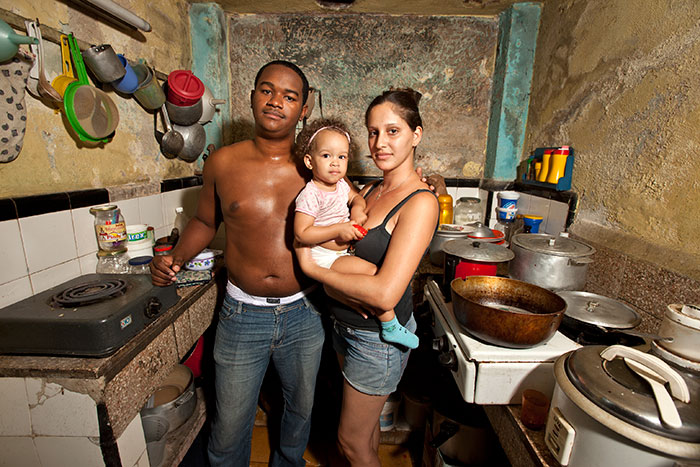
To be a Canadian tourist in Cuba is to be something more than a visitor, more even than a run-of-the-mill mark. It’s not just that you’re visibly foreign and rich; you’re a sort of modern vassal, the only readily accessible emissary of a metropole that has never been seen but is generally understood to be bounteous and benevolent.
Such were the macro-socioeconomic forces at work as we strolled down a broad downtown avenida on our first full day in Santiago. The traffic on the road was steady and loud, heavy with ancient GM trucks, diesel-belching Chinese buses, and antique Fords and Cadillacs with multiply rebuilt engines growling under their hoods. We stopped to admire the stunning facade of the Hotel Rex, a glorious art deco and neon relic from Cuba’s swinging ’50s. The Cuban Revolution was born in Santiago, and this was the hotel where the first Fidelistas stayed the night before their failed 1953 raid on the nearby Moncada Barracks. (Following the attack, Fidel, forced from Cuba for leading the attack, would meet Che Guevara during his Mexican exile, returning a few years later and capturing Santiago in late 1958—the first major victory of the revolutionary war.)
Later that morning, a young man waved to us from a concrete stoop half a storey above street level. He’d noticed my wife’s camera and invited us in to see his little photo studio. In his solid but thickly accented English, he introduced himself as Antonio.
The studio was a study in contemporary Cuban improvisation. It was located in the cramped front room of the old house, its walls crumbling and peeling in that signature Special Period way. The only light came from a single bare fluorescent tube mounted horizontally on one wall, its unearthly glare illuminating a threadbare white curtain. The sole piece of photographic equipment was a point-and-shoot digital camera that looked at least five years old and produced pictures several megapixels smaller than the ones taken by a basic smart phone. In Santiago, though, access to any digital camera evidently provided a sufficient foundation for a photography business.
Antonio and a couple of colleagues were taking pictures of a baby girl and her proud parents. Her first birthday party was this coming Saturday, and we were promptly invited to attend. We posed for pictures with the birthday girl and her family, and then they left and Antonio launched into a protracted monologue about the local photo business, Santiago (“the most Caribbean city in Cuba”), and his own Afro-Cuban heritage. He dug out his passport and showed us the visa from a trip he’d taken to Amsterdam a few years earlier. He had a couple of pictures of himself in a toque and a heavy coat in the Dutch winter. He knew a musician, he said, who had toured Canada. His ache for escape was palpable.
We left Antonio with a vague promise to return, perhaps for a tour of “the real Cuba,” perhaps for the birthday party. We were under no obligation, and we knew enough to be wary, but we meant it all the same.
It was a glorious day, warm under a gentle sun, and we strolled lazily down a nearby market street, stopping to gawk at the strange array of goods in the government shops. Cheap Chinese shoes and plastic toys were displayed on shelves or under glass in half-empty cases. There was a store full of knock-off electronics and tiny washing machines. All of it was bathed in late-afternoon shadow, the lights kept Save or Die low. Locals clutching creased ration books lined up out the door at an egg dispensary.
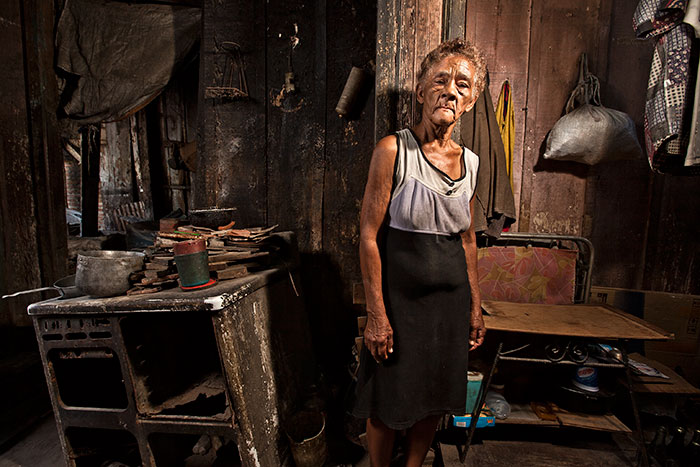
We came upon a nook where a young woman was selling ice cream bars. A small sign read “$3.00.” I asked for one and handed her three CUC $1 coins, realizing even as I dropped them in her hand that the sign was surely referring to nonconvertible CUPs. She whisked the coins away into a cubbyhole below the counter, trying hard to seem merely efficient. She handed me an ice cream on a stick and fixed me with a blank stare. I held her gaze for a yawning moment, not sure what I was waiting for. We were colonizer and colonized, deep in the fuzzy grey market of the tourist economy, wondering who would blink first. “Gracias,” I said finally, and we walked on down the street.
A few blocks farther along, I came to understand just how much I’d overpaid. The ice cream had been chalky and flavourless and we were still peckish, so we stopped at a corner where an old woman was selling roasted peanuts wrapped in paper cones. I gestured for one and handed her a twenty-five-centavo coin, a twelfth of what I’d paid for the ice cream. She was aghast. An old man standing next to her made an exaggerated goggle-eyed gesture of shock and then scooped up as many of the cones as his two hands could hold, nearly everything on her tray. Eventually, we settled on two cones for the quarter, for which she thanked us extravagantly.
I’d handed the girl at the ice cream stall a windfall. She sold lousy ice cream to locals from a stall on the state store shopping street in a largely tourist-free city. (Unlike Havana, which draws hordes of visitors on its own and many more on day trips from nearby Varadero’s crowded resort strip, Santiago is too remote for the package tour masses, three hours by road from the much smaller cluster of beach developments near Holguin.) She had no expectation of returning home that night with CUCs in her pocket—a week’s wage in a single, accidental hard-currency tip. But we were, after all, Canadians on the sunny end of thousand-dollar flights, and what did a couple of misspent CUCs matter here or there? The price of almost everything was arbitrary in Cuba. Normal rules didn’t apply. That was part of the fun.
We spent a week in Santiago, and only twice did we encounter anything like a posted exchange rate, both times at live music venues near the main square. The first was at the government-run Artex music store, which sells an exhaustive range of Cuban music CDs (after rum and cigars, probably Cuba’s most popular souvenir and its most widely adored cultural export). A small courtyard out the back features live music all afternoon and evening, and a sign at the top of the stairs leading down to the patio lists the admission prices in both convertible and nonconvertible pesos: “CUC $1.00/CUP $20.00.” Up the street at Casa de la Trova, the most storied music hall in Santiago if not all of Cuba, locals were paying CUP $25 for an admission ticket marked “CUC $1.00.”
Once, walking past a ration store, I saw rice listed on the chalkboard above the long, weathered wooden counter at $0.25 per pound (CUP, of course). At Patio de Artex’s twenty-to-one exchange rate, I’d paid CUP $60—enough to buy 240 pounds of rice—for one barely edible ice cream bar. We could have bought 160 pounds of rice for what we spent to watch an hour of music one fine afternoon on the patio.
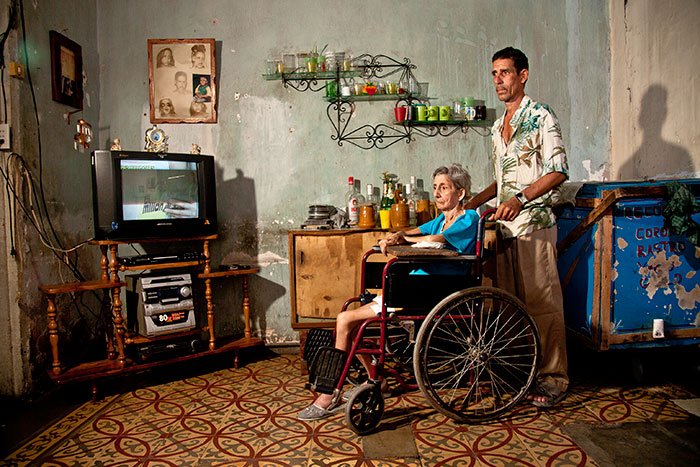
Let’s talk about that Patio de Artex show. It points to the most obvious reason, beyond the availability and convenience of cheap flights or the historical friendship or the incomparable quality of a real hand-rolled Cohiba, that more than a million Canadians visit Cuba every year (compared, for example, with the 754,000 who travel to the Dominican Republic, where prices are lower, the cigars and rum are equally plentiful, and the logistics are uncomplicated by Communist bureaucracy and the grim exigencies of the Special Period). It’s related to why it’s no accident that Cuba alone has managed to pass half a century in open, hostile defiance of the world’s most powerful nation just to the north. Every country has its character and customs and quirks, but there’s a depth of soul to Cuba that puts it in a class by itself. Cuban music has set the tone and the rhythm for much of Latin American music for generations, and it’s the most visceral manifestation of the island’s indomitable spirit.
So, yes, let’s talk about the Patio de Artex show. At the precipitous cliff’s edge of the Special Period, even after many grinding months of Save or Die austerity, you can still find a table at Patio de Artex on any old Friday afternoon and watch eight guys in donated T-shirts and Chinese jeans transform a courtyard into one of the best places on earth from which to launch a weekend. Mojitos sweating through plastic cups on the table, the trumpet player muting his horn with his hand to add a vampish growl to the son they’re tearing up, a propulsion in the rhythm that hauls even a hopeless, doubly left-footed non-dancer like me to his feet—this is what you get for your 160-pounds-of-rice admission at Patio de Artex. You get escape, transcendence. The show would have been a bargain at CUC $10 a head.
This is why Canadians come back again and again. And why, perhaps, they bring even more T-shirts and towels and acetaminophen the next time: because these people deserve more for their labour. They deserve better. Yes, this is true of any picturesque beach destination in the impoverished tropics, but in Cuba it’s somehow more undeniable. Maybe it’s the grinding workaday cruelty of the Special Period, the utter absurdity of America’s ongoing embargo. Maybe we delude ourselves, in Mexico or Jamaica, with the notion that the society’s nominal freedom means no absolute barrier exists between our decadent days by the pool and the women slaving away at the messes in our hotel rooms. Anyway, there’s something about Cuba that brings the arbitrary nature of wealth and power and material comfort into especially high relief. And so we bring stuff. Gifts. Offerings. Talismans of apology and absolution.
Live music is not hard to find in Santiago de Cuba. The city prides itself on being the place where African rhythms first mated with Spanish harmonies and instrumentation to produce the itinerant nineteenth-century musical tradition called trova, the wellspring of Cuba’s world-conquering musical culture.
One evening at Casa de la Trova, we caught a fantastic seven-piece group called Ecos del Tivoli who performed in matching suits. At other shows, we heard “Chan Chan,” the Buena Vista Social Club’s signature tune, played about a dozen different ways. We went to the paladar closest to our hotel early one night, and they opened up just for us, and before they even took our orders a kindly older man in a fedora showed up with a guitar to serenade us (his yearning take on “House of the Rising Sun” was a highlight). We bought one of his son band’s CDs (CUC $10, counting a tip for the serenade) and then saw him in the crowd a couple of nights later at Casa de la Trova, where he cajoled a prostitute into showing me a couple of moves on the dance floor.
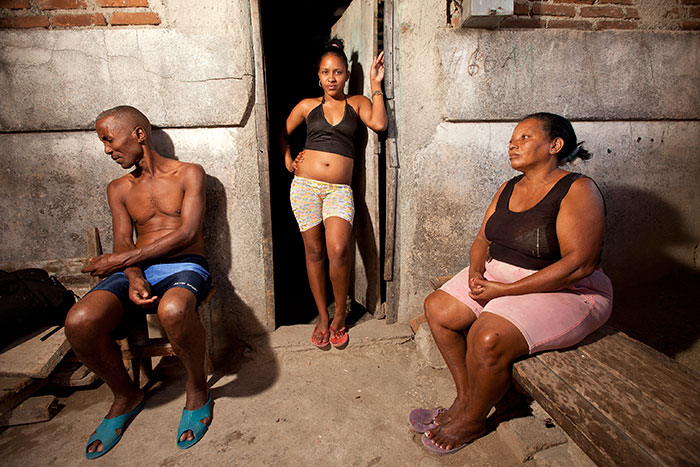
One afternoon, as we wandered the back streets around the original Bacardi rum distillery, an old woman approached us on the corner. She explained that she worked in economics and computers but her lifelong passion was opera, and then she asked if we’d like to hear a song. As locals strolled past with little more than a glance—just another afternoon in Santiago—she treated us to a passionate mambo in a voice that revealed years of classical training.
On Calle Heredia, a side street near Santiago’s main square, there is a small tourist market. Sidewalk vendors hawk handicrafts, and behind them small shops and kiosks trade in antiques, art, and souvenirs. I repeatedly visited one in particular, a place the size of a walk-in closet stuffed to the rafters with books, postcards, and old Cuban LPs. As soon as I expressed an interest in the records, the shop’s proprietor, a genial senior citizen in a newsboy cap, grinned at me around his cigar stub and started yanking out records and throwing them on his phonograph. He tangoed around his shop, pouring out coffees for both of us. I bought priceless son records for a CUC or two apiece, and a small stack of ’70s back issues of Bohemia—once one of Latin America’s most important magazines—for the same unit price. For reasons I never fully understood, the old gent threw in a freebie, a fold-out postcard packet dated 1958, featuring photos of the La Seo Cathedral in Saragossa, Spain.
What would you consider a fair price for admission to one of the best musical theme parks on earth? Twenty bucks? Fifty? What do they charge to get into the Grand Ole Opry in Nashville? If they’d asked me, as we boarded our flight home, for CUC $10 for the old lady’s street corner bolero, I’d have paid it gladly. What I felt most acutely, weeks later, is that I’d failed repeatedly to leave an adequate tip.
Let’s talk about where to eat in Santiago (and how to under-tip there). The state-run restaurants—the CUC joints for tourists, as well as the CUP places for locals—are a complete waste of time. The food in the family-run restaurants, the paladares, is in another league entirely. Paladares were black market operations, just a couple of tables in someone’s family kitchen, until the mid-’90s, when some of them were licensed and subjected to byzantine regulations and steep fees. The unlicensed ones, though, remain the best, and we found one around the corner from another trova hall, the Casa de las Tradiciones, simply by asking the guy at the door if he knew of a place nearby to eat.
He led us briskly up a side street, where seemingly every twentysomething male in the neighbourhood was gathered around a boisterous roadside domino game. As we approached, a young man stepped away from the crowd and introduced himself as Luis. He led us a couple of blocks farther along to a tiny bungalow and invited us to take a seat in the living room, where a woman who appeared to be his grandmother was watching telenovelas. Luis disappeared into a back room for what felt like half an hour. When he finally returned, he ushered us past the kitchen, through a narrow bedroom with kids’ bunk beds against one wall, and down a concrete staircase to a small patio. A single table had been set immaculately before a panoramic view of Santiago Bay. Trova played on a portable stereo while our host, with a veteran tour guide’s ease, rattled off historical details about Santiago’s port and its slave trading history.
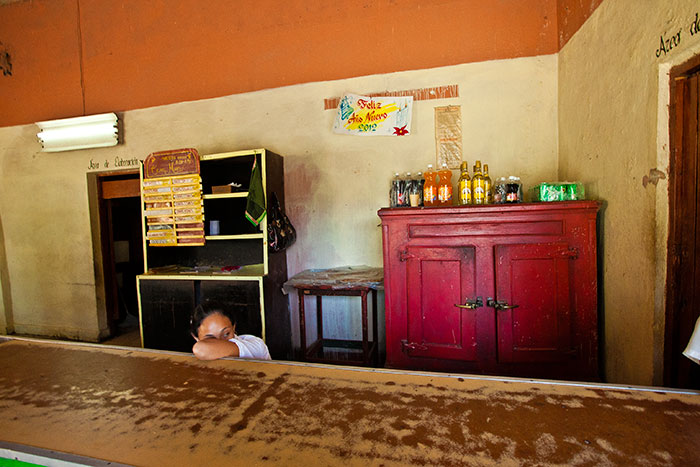
We noticed a small shrine on the corner of the patio, a wooden box standing on its end, the open side facing outward, with dolls, a bowl of coins, and an egg on a tray arranged inside. There was a cigar and a small wooden cross on top, and a chalk circle drawn on the concrete in front of it, around markings of arrows and skulls. Luis explained that he practised a syncretic faith called Palo Monte, a common Afro-Cuban religion similar to Santeria. We mentioned that it was the only shrine we’d seen. Everyone has them, he replied, but he didn’t bother hiding his. He gave us a business card with the name and address of the paladar, the only one of those we saw as well. Amid Cuba’s current evolution, Luis was more concerned with positioning his modest business for the next phase than with keeping it from the authorities in the last days of this one.
“In Cuba,” he told us, “today is today. A hoy es hoy. Mañana is another time.”
He served us a variation on the mojito, using basil leaves instead of mint. He called it an alto del mar—“above the sea,” also the name of his paladar—and it was the best drink I had in Cuba. Dinner was whole fried fish garnished with the only red pepper we saw in Santiago, and a delicate creole sauce that was several steps above the licensed paladares’ offerings in its refinement. When I asked for the bill, he brought me a scrap of paper with “$14.00” written on it. I gave him CUC $20, under-tipping for one of the most memorable meals I’ve eaten anywhere.
Luis’s place was just a couple of blocks from the Museum of the Clandestine Struggle, which we visited a few days later. It was a shrine of another sort, its glass cases containing carefully preserved bloodstained suits and Molotov cocktails from the guerilla street war fought block by block in Santiago for years ahead of Fidel’s return from exile, testimony to the long-standing Santiagueran tradition of defiance.
Outside, we stopped to watch three teenagers playing an impromptu stickball game in the street. They had a broom handle for a bat, and they were hammering some kind of makeshift ball off the surrounding buildings with such authority it took a while to realize it wasn’t even round. It was an empty pill bottle. I had a sudden, sick flashback to our visit to the Walmart in Antigonish and the “baseballs” entry on my shopping list. I’d searched the sporting goods section for baseballs, but in December in Nova Scotia there weren’t any. I’d had a sleeve of tennis balls in my hand at one point but had put them back. With a staggering lack of perspective, guided by some deranged sense of propriety, I’d thought to myself that Cubans were world-class ballplayers who surely honed their batting skills using a properly weighted baseball. Now, though, it was the grandest of my under-tips: the one not given.
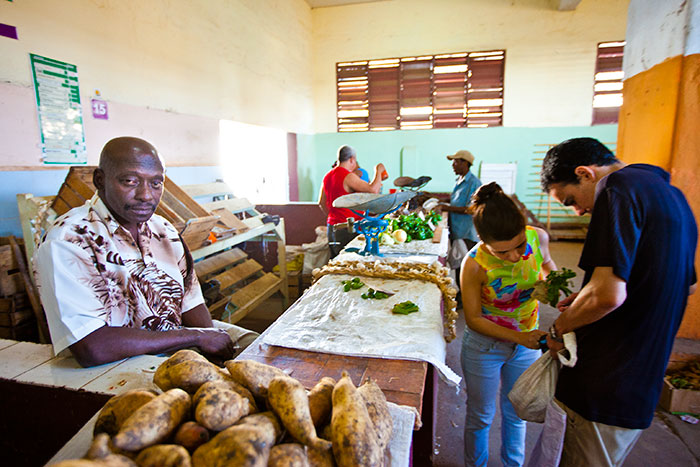
The Brisas Sierra Mar is a slightly dishevelled three-star resort sixty-five kilometres down the coast from Santiago, a drive that takes nearly three hours along the craziest lunar-landscaped road I’ve ever encountered. The hotel is a standard-issue all-inclusive: a pool with a swim-up bar, a few restaurants and lounges, an open-air amphitheatre for nightly cultural shows, a dive shop, a beach that was really something before Hurricane Dennis reduced it to a thin strip of sand in 2005. The clientele was at least three-quarters Canadian when we arrived, a significant number of them repeat visitors who came yearly or even more often, and they lent the place a friendly summer camp vibe. The package tour operators near the front desk all kept binders full of details on excursions, and every one of them described a Cuba beyond the gates where dangerous con artists lurked on every corner; the binders all warned against any unaccompanied travel whatsoever outside the resort.
We had come to Brisas Sierra Mar to dive. The divemaster was a soft-spoken, sharp-witted family man named Edgar. We were the only divers who’d never visited the resort before, and everyone else on our excursion asked after his family. His daughters had been sick, he said, with a pointed shrug that suggested illness could go further south in Cuba than you really wanted to talk about.
Cuba’s coral reefs are currently rife with lionfish, stunning creatures with brilliant black and orange stripes and a broad mane of poisonous antennae protruding from their fins. Native to the South Pacific, they are an invasive species in the Caribbean that feasts on defenceless hatchlings up and down the reefs. Edgar brought a speargun on most dives to take out as many as he could, and so one of the great spectator sports was watching the divemaster hunt lionfish. One day, he filleted a few of them back at the dive shop, expertly slicing away the venom-tipped fins using a pair of spears as an Asian cook wields chopsticks. The chef at the beachfront restaurant breaded and deep-fried the fillets for us and served them with fries: lionfish and chips, easily the most memorable meal at the Brisas during our stay.
The morning we left, I headed down to the dive shop with a plastic shopping bag stuffed with gifts for Edgar: a big bath towel, a binder and a children’s notebook with a tiger on the cover that our daughter had picked out, plus bottles of ibuprofen, Dramamine, and a children’s anti-nausea medication called Nauzene. Edgar had called in sick that morning, but the caretaker at the shop said I could leave the bag in his office. I went in, set it down under Edgar’s desk, and then hesitated: what if someone else took it? There was no record of it, of course, no way to guarantee Edgar and his sick daughters would get it. I was invested, I realized, in the arbitrary personal connection. I wanted Edgar to know I was looking out for him. This is often the way of gift giving in Cuba—it’s not enough to be the colonial master of the exotic treasures, dispensing them with a sovereign’s whim. Even in the act of charity, we want tribute. We want to take a little gratitude home with us.
I left the bag in Edgar’s office, knowing that whoever wound up with its contents, their value would be immediately understood and cherished. The stuff would be used and reused, used up, exhausted of its value, and then repurposed. An empty econo-sized ibuprofen bottle would, after all, make a serviceable baseball.
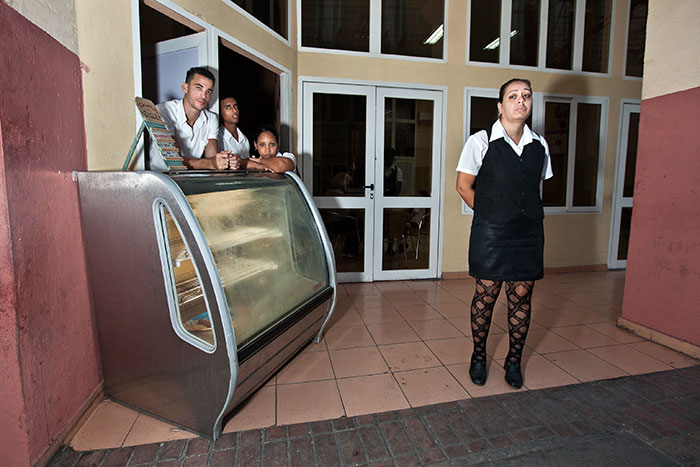
I wasn’t ready for the condition of Antonio’s home. There are more flattering ways to say it, but at the end of the tour in Santiago when he invited us back, it was so much worse than I expected. I was imagining something like the places that lined the streets on our meanderings around the city: tidy concrete bungalows, cramped but homey spaces like Luis’s place.
Antonio led us down an alleyway in a densely populated neighbourhood near the photo studio. There were jumbles of concrete piled atop one another in behind the homes you could see from the street, places filigreed with rusted rebar and roofed in salvaged tin. Antonio lived with his young wife in one of them, which was stacked on top of the slightly larger concrete slab where his mother and sister lived. The entry was up a rickety flight of repurposed wooden stairs. There were two rooms: a front living area with a sink in one corner piled with dirty dishes, and a larger back room with a mattress on the floor. There was a Chinese boom box in the front room with one of those outsize, blinking blue-green displays, and a poster of a Dutch league soccer team tacked to the wall above it. It was a makeshift place, a slum dwelling.
Antonio had had his friend drive us all over town in an ancient Soviet-made automobile mostly held together by force of will. We’d passed grand colonial mansions—“the houses of the people in Miami,” Antonio explained—that now housed educational facilities and cultural centres. He’d taken us to an Afro-Cuban cultural centre and museum that we’d never have found otherwise. On the way to the Spanish fort outside town, we’d pulled off the road and waited while he ran to the stoop of a bungalow to procure two bottles of rum with legendary Matusalem labels. No one has made rum under the name of Matusalem in Santiago since Fidel nationalized the distillery, but it was premium stuff for the discount price of CUC $10 per bottle. He’d known just the right restaurant, an unsanctioned paladar that turned out delectable grilled lobster. Throughout, Antonio was personable, forthcoming, full of information and generous with it. He was bilingual, literate, and quick witted. His needs were obvious, unmistakable.
I forgot all that. That he was achingly poor, and I impossibly rich. That his madly uncertain future was riding on how many CUCs he had when the Special Period’s precarious economic dance stopped and rendered them as worthless as Ostmarks. In the instant he took the ten-peso note from my hand, I was simply a colonial officer standing before him, momentarily indignant. There had been gifts, and there would be more, and how dare he presume to decide when and where and how they were to be bestowed?
That’s the real value of ten convertible pesos: under the right circumstances, it will show you exactly who you are in Cuba. You might not like what you see, but it’s still well worth the price.
The day before we left Cuba, we took a taxi to Gibara. Before the Spanish colonists built the country’s first railroad and placed its terminus in Santiago, the smaller city had been a major port for the sugar trade. Nowadays, it is a sleepy warren of dilapidated colonial mansions fronting on a gorgeous, breezy stretch of Caribbean Sea. While it’s less than an hour’s drive from the international airport in Holguin—closer, actually, than the strip of all-inclusive resorts farther down the coast—it sees only the occasional handful of day trippers on excursions. The locals are friendly, the accommodations at private guest houses in those ancient mansions charming if not quite grand, the seafood abundant and delicious. It’s a breezy, laid-back, disintegrating dream of a place. Gibara is, in other words, the quintessential off-the-beaten-track hideaway, the sort of place Lonely Planet built a guidebook empire discovering.
We adored Gibara. For CUC $10 each per night, we had a comfortable room in a high-ceilinged colonial townhouse with a broad, quiet, hammock-strung courtyard in back. Within a couple of hours of our arrival, we’d already begun speculating on how cheap and easy it would be to hop a winter charter to Holguin and spend a month there living on next to nothing.
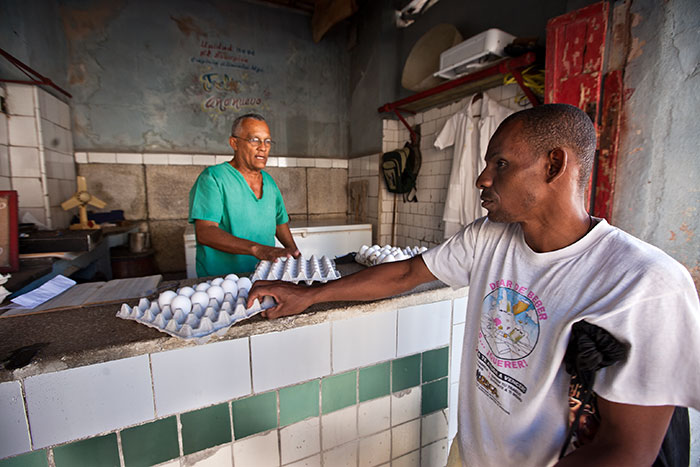
At sunset, we wandered down to the harbour to watch a ferry arrive. It disgorged a steady stream of locals in work clothes on foot, and I’d just begun to wonder if they were employees at the resorts up the coast when my wife, who was taking pictures, slipped off the edge of the curb and twisted her ankle. A crowd soon gathered around us, the faces charged with real concern. Everyone said we should go to the hospital, and someone offered to find us a ride. My wife insisted she was fine; she just needed to rest a minute.
“You’re hurt,” someone said. “Look at your ankle. Why not go?”
“We’re Canadian,” my wife answered.
“It’s for everyone. Just go.”
Cuba has one of the best health care systems in the developing world. Its medical schools train doctors from across Latin America and beyond, and it sends its skilled health professionals all over the globe. Cubans are, as we learned in an instant, offhandedly but beamingly proud of their hospitals. I can’t think of anywhere else I’ve been where the default response to an ankle twist was to go immediately to the hospital.
So we went. It was full dark by the time we arrived. The halls were sporadically under-lit by naked bulbs and fluorescent tubes, the walls and furniture crumbling. We were directed to a waiting area, and my wife was seen ten minutes later by a pair of attentive young doctors, who wrapped her ankle and advised her on care. No one asked us for money or anything else. We were back at our guest house half an hour after we’d left.
This is how Cubans are with what little they have, the things that might be of use to us. Take it, as much as you need. Don’t hesitate, don’t be shy. Just go.
After my wife was settled in bed, I returned to the hospital. I had a bag with me, our final gift to the Cuban people. My Spanish was so weak and disjointed, the people in the entry hall thought I was a bit unhinged at first, but once I showed them what I had in the bag they found a doctor upstairs to sit with me and register the donation. One large bottle of acetaminophen. The six remaining pills in a blister pack of a dozen decongestants. One bottle of gas relief drops for infants. Two-thirds of a twenty-pack of ballpoint pens. Everything we had left. The least we could give a hospital that offers aid to anyone who shows up on its doorstep but can’t reliably purchase its own medication.
The next time we go to Cuba, we’ll bring much more, and I’ll remind myself to tip better. I’ve decided on a CUC $10 minimum. It’s only fair.
This appeared in the April 2012 issue.




